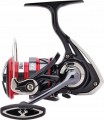Number of bearings
The number of bearings provided in the design of the reel. Bearings are used to reduce friction of rotating parts, which, on the one hand, protects such parts from wear, and on the other hand, reduces excessive effort expended when the handle is rotated. Accordingly, the
more bearings, the more friction units are protected and the better the coil is “optimized”; this parameter is a good indicator of the overall class of the product. At the same time, it is necessary to evaluate different models taking into account their purpose (see "Type").
So, in fly fishing reels, even quite expensive ones, 1 bearing is usually provided — at the point of installation of the drum on a bracket designed for attachment to the rod. This is actually the only significant friction point, so more bearings are simply not required. For multiplier reels, this number varies from 1 for relatively simple options to 6 – 7 for premium ones. And in inertia-free bearings, the number of bearings can reach a couple of dozen.
Instant anti-reverse
Instant stop of the reverse motion of the coil when unwinding. It is very important in jig fishing with stepped wiring, when you need to quickly make 2 – 3 turns and an instant stop. The function is no less in demand in feeder and carp fishing, when you need to slightly tighten the fishing line in order to put a little tension on it for a good fixation of the moment of bite, but at the same time not to move the bait from the bottom. And also an instant stop will not be superfluous when fishing on the current.
Weight
The total weight of the reel (only the device itself, without fishing line). This parameter is important, first of all, for those who select equipment of
the ultralight class — in such gear, the struggle is, as they say, for every extra gram. In other cases, you can not pay special attention to weight.

